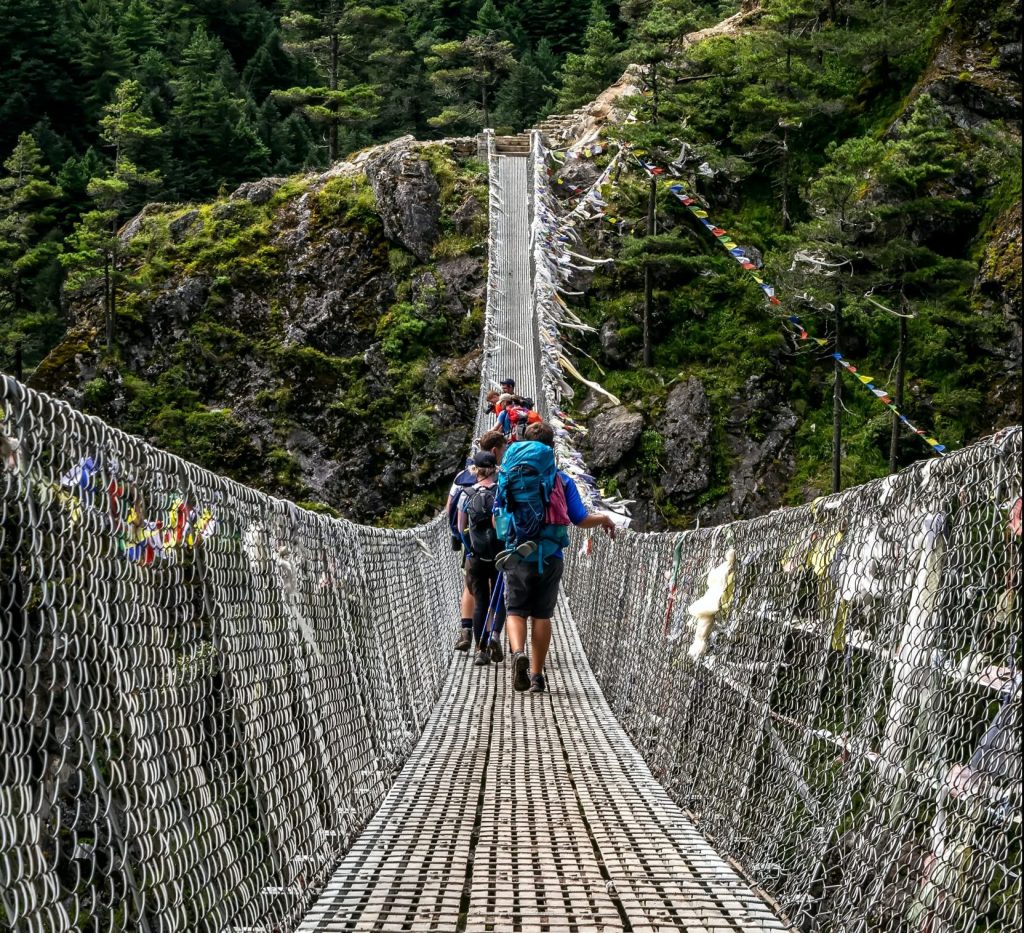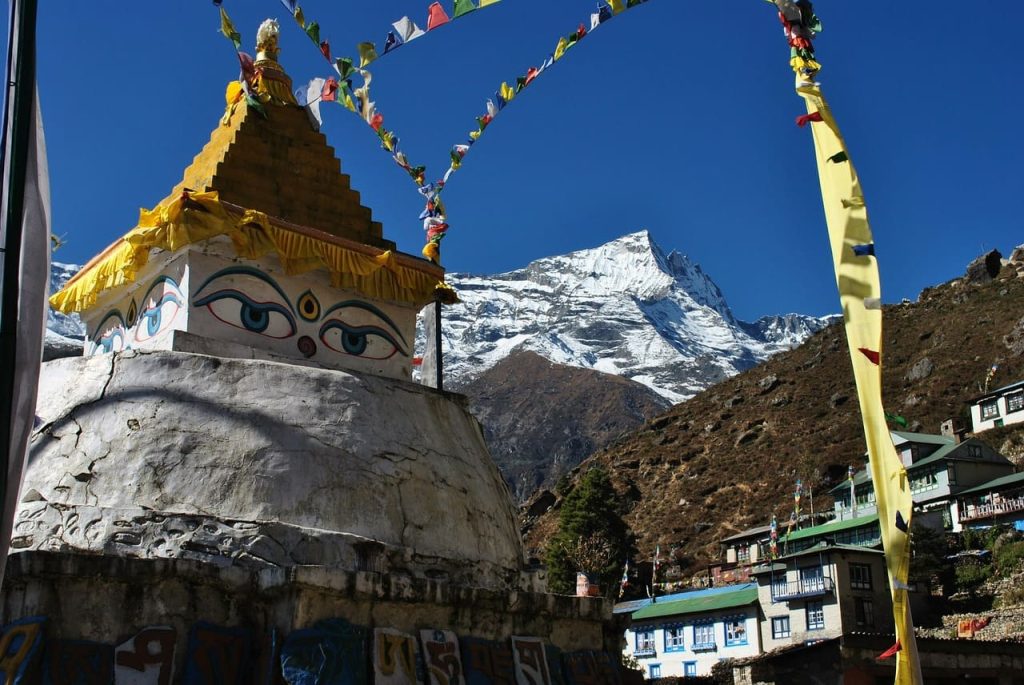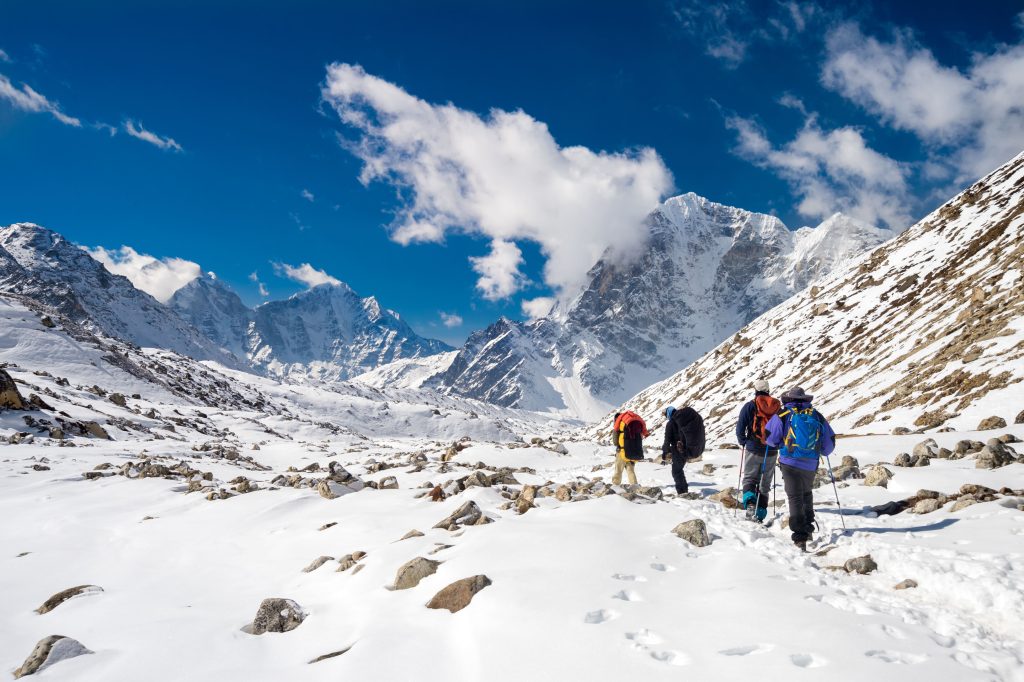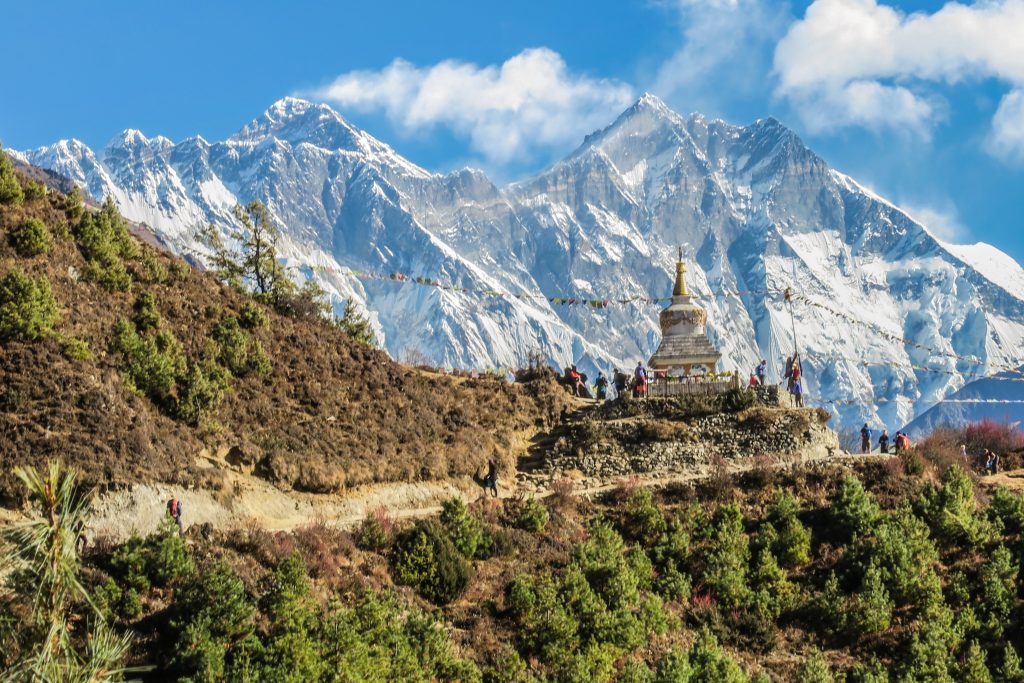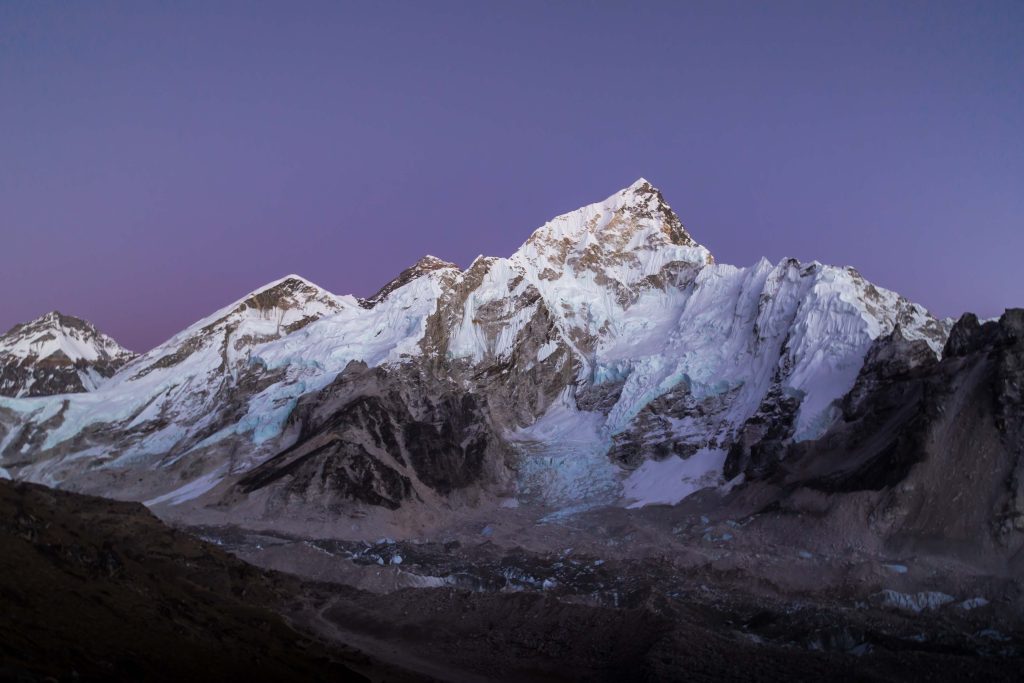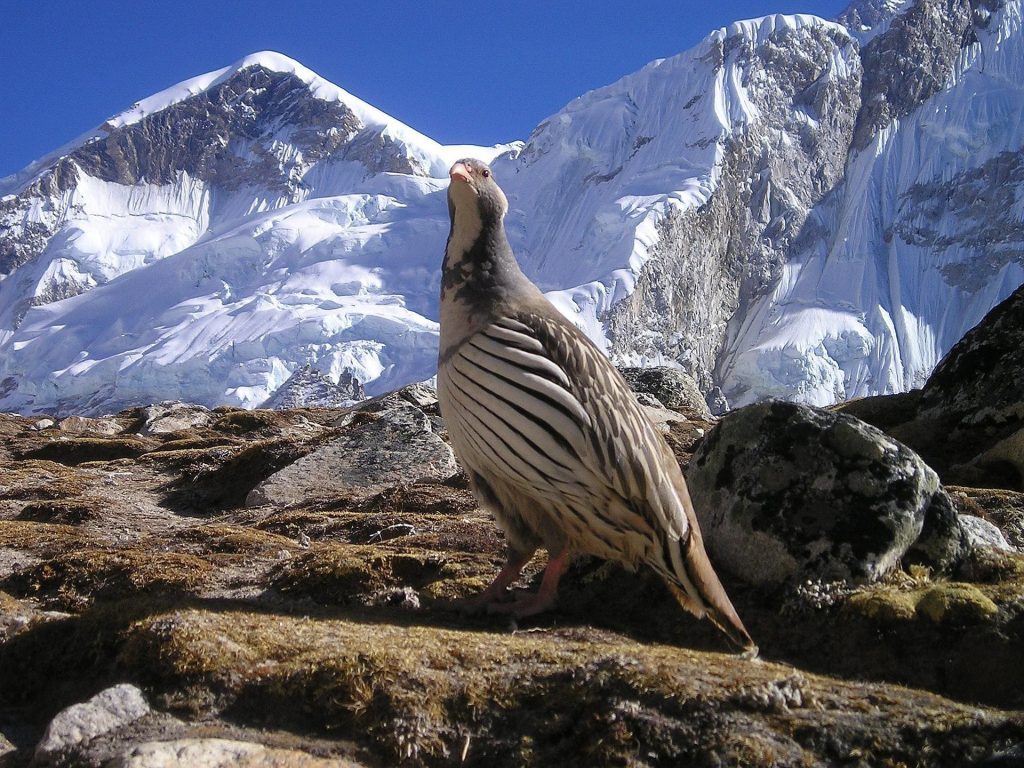Everest Base Camp (17,598ft)
Follow in the footsteps of Edmund Hillary and Tenzin Norgay, to Everest Base Camp. Trekking through the Everest region offers astounding mountain views, and opportunities to get a glimpse into the life of world famous climbers (the Sherpas). The trek further offers the opportunities to go sightseeing around Sagarmatha National Park, a world heritage site that is home to a variety of Himalayan floras and faunas. It also gives an opportunity to get a closer look at the highest Buddhist monasteries in the world, and, of course, the most gratifying of them all, the trip to Everest Base Camp itself. The opportunity to embark on the remarkable journey that Sir Edmund Hillary and Tenzing Norgay Sherpa took, and the feeling of being able to view the mighty Everest up close is second to none.
Highlights
- ● Religious, cultural and historical sites of Kathmandu.
- ● Scenic flight to and from Lukla.
- ● Breathtaking panoramas of the mountains including Everest.
- ● Exploration of 200 years old Tengboche monastery, Pangboche monastery.
- ● Panoramic views from Kalapather of the dozen of peaks and Tibetan plateau.
- ● Step inside and experience life as the "mountain people" live, in the hearth of Himalaya.
- ● Best Sherpa, support staff and logistics.
You’ll be picked up whenever you arrive in Kathmandu Airport, and taken to your hotel and after checking in, you could walk around Thamel, a popular tourist hub in Kathmandu. Observing the market and some souvenir shopping will freshen your mind.
Dinner at an excellent restaurant will give you a taste of Nepali cuisine.
Your trek guide will brief you about the trip and the next day’s sightseeing trip.
All accommodation and transport is included on this trip.
After breakfast at the hotel, get your bags loaded in the bus and start a guided sightseeing tour to
three UNESCO World Heritage sites of Kathmandu valley that have historical and spiritual values. We visit Pashupatinath, Bouddhanath Stupa and Bhaktapur then eat lunch. Then we set off to Ramechhap which takes roughly between 5-6 hours. Spend the night in the camp resort by the Tamakoshi River.
This is your first day of trekking in Nepal after a scenic flight to Lukla Airport in the Everest region. Upon arrival at Lukla, you’ll meet our other crew members and after some packing and arrangements, we start our trek through the prosperous village of Lukla until we reach Phakding along the Dudh Kosi River and spend the night in the village. Overnight in Phakding.
On day 4, you continue along the Khumbu valley to Namche Bazaar – the largest town on the trek.
Walking through a beautiful pine forest, the track leads us along the Dudh Koshi River through many suspension bridges, one of which is the famous Hillary Suspension Bridge with wonderful viewpoint of the gleaming Mt. Thamserku (21,713ft). Namche Bazaar crisscrosses over the river in route to Jorsale, the trek’s halfway point. We pass through the last village of Jorsale before reaching Namche Bazaar. Later in the day, finish with a challenging uphill climb to Namche Bazaar. Enjoy the first glimpse of Everest. Overnight in Namche Bazaar.
The air is very thin here – with just 65% of the oxygen at sea level – so day 5 are used to acclimatise. You’ll do a short but spectacular acclimatisation hikes, so that you’re refreshed and ready for the trail ahead. You’ll hike to the view spot to enjoy the great view of Mount Everest, Thamserku, Lhotse, and Ama Dablam which is often considered the most beautiful mountain in the world.
Then you’ll hike back to Namche Bazaar, and stay for the night.
The trail now forks northeast along a tributary valley with the mountain views opening up to become very dramatic as the steep climb approaches the holy ground of Tengboche. Monastery, yak pasture and world’s highest sacred institution combined! Amazing views, Nuptse, Lhotse, Ama Dablam and Everest. Overnight at Tengboche.
Trekking past the Gompa, which holds the famous Yeti scalp, at Pangboche, are the summer yak pastures and here lies no doubt as to the Spartan lives of Sherpas. Beyond this, it is as well to understand that overnight sleeping facilities can reflect the harshness of our surroundings. Much of the walking in this area is of comparatively gentle gradient, although a leisurely pace is anyway recommended due to the high altitude. Overnight at Dingboche.
A second acclimatisation day, with optional hikes to Nagajun Hill or Chukung village, with fine views of Ama Dablam, Makalu and other peaks, interspersed with lakes and glaciers. Overnight at Dingboche
Ascending at a sensible pace, traversing ice covered torrents, to Lobuche where stone houses sit amongst a frozen wilderness of stunning beauty and where exists a thrilling sense of closeness to our ultimate goal. Overnight at Lobuche.
The goal that is Everest Base Camp is a demanding day. Here the Sirdar’s duty is to have you safely navigate the Khumbu Glacier so as to have Khumbu’s infamous Icefall impose itself, leaving only the awesome, humbling South Face beyond. You will climb up to Gorakshep and trek to Everest Base Camp. We’ll be standing at the base of the tallest mountain on Earth. Reaching Base Camp fills one with a
real sense of achievement as we’ve done what we set out to do hard catching breaths and spend some time at EBC then descend back to Gorakshep for the overnight rest. Overnight at Gorakshep
The best vantage point for viewing Everest and the surrounding peaks at sunrise, as if not just Everest but the entire world is breathtaking. Then descend to the flat and sandy expanse of Gorakshep. You’ll climp up again to reach to Kalapathar, for the scenic view of Everest and many other mountain, and on down to Pheriche. Overnight at Pheriche.
And so down to Tengboche. The trail descends gently, crossing the Dudh Koshi torrent that higher up had been the glacier of Khumbu, then, leaving behind alpine meadows, the trail descends to Tengboche for the night. Overnight at Tengboche.
After seeing the magnificent view from Tangboche, you will descent down to Phunke Tenga, and another few hours to Namche. Overnight at Namche.
After having a good night at Namche you will descend to Lukla. On the way you will cover the forest of rhododendron and pine. After walking a while you’ll reach a Sherpa village to say good bye and thank you to the local team staff. On undulating terrain, you will arrive at Lukla. Overnight at Lukla.
Today will be your last day at Khumbu region as you fly back and get to Kathmandu after your mountain journey. Back in Kathmandu, you can spend some leisure time reflecting on the trek and doing last-minute shopping in Thamel. You’ll meet up for dinner in the evening and celebrate successful completion of our trek. Overnight in Kathmandu.
An amazing trip to the Himalayas concludes on this day. You’ll be dropped off at the airport approximately 3 hours before your scheduled flight.
Have a safe flight back!
Note
The itinerary(s) for each tour MAY CHANGE depending on prevailing local weather and environmental conditions. In such cases our guide(s) or our staff will arrange the best alternative activities to match your original program. The completion date of your tour will always coincide with the original itinerary.
Included:
- Transfers to and from the airport
- Kathmandu valley sightseeing via private vehicle and tour guide
- Domestic flight from Kathmandu to Lukla and back
- All accommodation on twin-sharing basis
- 3-Star accommodation in Kathmandu and Pokhara
- One English speaking city tour guide
- One English speaking Leader from arrival to departure
- One assistant leader for every 4 clients
- One porter for every 2 clients
- Insurance, wages, meals and accommodation of crew members
- Permits, entrance fees and government tax where applicable
- Industry standard first aid kit
Excluded:
- Visa Fee
- Travel/rescue Insurance
- International flights
- Food - we recommend you allow $700 USD for food on the trek
- Warm showers in the tea houses
- Water and other beverages, wi-fi, charging mobiles, cameras and other electronic devices during trekking
- Optional activities
- Late check out on hotels
- Services not mentioned in the itinerary
- Tips and gratuities
- Extra expenses due to unforeseen events such as natural disasters, roadblocks and health conditions of fellow travelers.
Available Trips
| TRIP DATES | AVAILABILITY | PRICE | SPACE LEFT | |
|---|---|---|---|---|
| October 7, 2024 - October 22, 2024 | Guaranteed | $1,390.00 |
12 Available
|
|
| October 21, 2024 - November 5, 2024 | Guaranteed | $1,390.00 |
12 Available
|
|
| October 28, 2024 - November 12, 2024 | Guaranteed | $1,390.00 |
12 Available
|
|
| November 4, 2024 - November 19, 2024 | Guaranteed | $1,390.00 |
12 Available
|
|
| November 11, 2024 - November 26, 2024 | Guaranteed | $1,390.00 |
12 Available
|
|
| November 18, 2024 - December 3, 2024 | Guaranteed | $1,390.00 |
12 Available
|
|
| December 9, 2024 - December 24, 2024 | Guaranteed | $1,390.00 |
12 Available
|
|
| December 16, 2024 - December 31, 2024 | Guaranteed | $1,390.00 |
12 Available
|
|
| March 11, 2025 - March 26, 2025 | Guaranteed | $1,390.00 |
12 Available
|
|
| March 18, 2025 - April 2, 2025 | Guaranteed | $1,390.00 |
12 Available
|
|
| March 25, 2025 - April 9, 2025 | Guaranteed | $1,390.00 |
12 Available
|
|
| April 8, 2025 - April 23, 2025 | Guaranteed | $1,390.00 |
12 Available
|
|
| April 15, 2025 - April 30, 2025 | Guaranteed | $1,390.00 |
12 Available
|
|
| April 22, 2025 - May 7, 2025 | Guaranteed | $1,390.00 |
12 Available
|
|
| May 6, 2025 - May 21, 2025 | Guaranteed | $1,390.00 |
12 Available
|
|
| May 13, 2025 - May 28, 2025 | Guaranteed | $1,390.00 |
12 Available
|
|
| September 17, 2025 - October 2, 2025 | Guaranteed | $1,390.00 |
12 Available
|
|
| September 30, 2025 - October 15, 2025 | Guaranteed | $1,390.00 |
12 Available
|
|
| October 7, 2025 - October 22, 2025 | Guaranteed | $1,390.00 |
12 Available
|
|
| October 21, 2025 - November 5, 2025 | Guaranteed | $1,390.00 |
12 Available
|
|
| October 28, 2025 - November 12, 2025 | Guaranteed | $1,390.00 |
12 Available
|
|
| November 4, 2025 - November 19, 2025 | Guaranteed | $1,390.00 |
12 Available
|
|
| November 11, 2025 - November 26, 2025 | Guaranteed | $1,390.00 |
12 Available
|
|
| November 18, 2025 - December 3, 2025 | Guaranteed | $1,390.00 |
12 Available
|
|
| December 9, 2025 - December 24, 2025 | Guaranteed | $1,390.00 |
12 Available
|
|
| December 16, 2025 - December 31, 2025 | Guaranteed | $1,390.00 |
12 Available
|
|
| March 11, 2026 - March 26, 2026 | Guaranteed | $1,390.00 |
12 Available
|
|
| March 18, 2026 - April 2, 2026 | Guaranteed | $1,390.00 |
12 Available
|
|
| March 25, 2026 - April 9, 2026 | Guaranteed | $1,390.00 |
12 Available
|
FAQs
Expand/Close
Everest Base Camp requires you to trek at altitude for up to 8 hours per day, with a small 10-15lbs rucksack. We recommended to train with long hikes and/or a sport of your choice (e.g. jogging).
The minimum age for this trek is 18, or 16 with a parent/guardian.
The Himalayas can change rapidly and the guides may be forced to change the trip itinerary accordingly. Travelers need to be prepared for all weather conditions. For more information please read the kit list provided.
Low Season (End Nov – March)
Daytime temperatures will be cooler, and the nights will be very cold. The days can bring winter storms, with regular snowfall above 8,500ft. Domestic flights are difficult at this time of year.
Monsoon (Jun – Mid Sep)
Temperatures are hot, with heavy rainfall almost every day. Trails can be very muddy, with frequent thunderstorms and high winds.
Trekking season (End Mar-May & Mid Sep – End Nov)
The most popular time to trek with mild – warm days and cold nights. The mornings tend to be clear, with some short rainfall in the late afternoons. In the higher altitudes, the temperatures often drop below freezing in the evening. At Everest Base Camp, the temperatures can drop as low as 5°F.
Documents
• Passport
• Travel insurance details
• Boarding passes for flights
• 2 passport photos
• Driver’s license (if needed)
• Cash USD
• Credit/Debit Card (Ensure you have $500 on your card incase an emergency helicopter evacuation is needed)
Sleeping
• Sleeping bag (Comfort rating -15 Celsius recommended)
• Sleeping bag liner (Optional)
Footwear
• Trekking boots: 3 or 4 season lightweight
• City footwear: Sandals
• Shoes for the plane and tea houses (Optional)
Clothing
Please make sure that you have non-cotton clothing for trekking.
• Base-layer t-shirts (e.g. running t-shirts)
• Fleece/Windproof jacket
• Waterproof jacket
• Down jacket for warmth
• Travel clothes and City Wear
• Underwear
• Base-layer trousers (optional)
• Waterproof trousers
• Trekking trousers
• Trekking shorts (Optional)
• Thick wool mountaineering socks
• Lightweight and breathable trekking socks
• Gloves and wool hat
Other
• A daysack: 35 litres
• A duffel or rucksack with straps to go over your back (Max 8kg of weight for porters to carry)
• Dry Liner or Dry Bag
• Water bottle/thermos: At least 2L. Nalgene bottles best.
• Sunglasses
• Sunscreen
• Personal medication – Inhaler, Blister pads etc
• General Toiletries, Contact lenses, Glasses (if needed)
• Towel
• Electronics – Head torch, travel adaptor, phone & charger
• Lip balm
• Book
• MP3/Music and headphones
• Travel wash
• Hand sanitizer, wet wipes
You can rent a sleeping bag and down jacket at $2 each per day.
You can buy everything in Kathmandu. There are many outdoor gear shops – some sell genuine brands and some are filled with cheaper imitation.
We advise you to leave unnecessary weight and things at the hotel, specially laptops, ipads, suitcases etc. The hotel you are booked at provides a storage facility free of cost.
Currently, all foreign nationals (except Indians) require a visa to enter Nepal. Visas are obtainable from embassies abroad or on arrival at Kathmandu’s Airport. If getting the visa at the airport be prepared for long queues. You will also need to provide one passport photo and the $50 USD fee if staying for less than 30 days.
You can arrive at any time on the start date of your trip, and you’ll be picked up from the Airport. We recommend you fly out on the afternoon of the last date of your trip, as the internal flights the day before can be delayed in poor weather.
You stay in Hotels in the city of Kathmandu and Tea Houses whilst you are on the trek. The Hotel will be 3 stars. The Hotel is a twin shared room, but you can get your own room for the 3 nights for an additional charge. The hotel has access to showers and intermittent internet.
If you would like to book any additional nights at the hotel, then please contact them directly.
The teahouses are very basic. Some of them have squat style toilets, whilst others have Western style. Showers do not always offer warm water and most teahouses will charge you for use of a hot shower.
Meals are available from teahouses, but all food has been carried up there by porters, so the higher up you go, the more expensive it becomes. Some teahouses do have access to the internet but at a cost.
Hotel Holy Himalaya, Bramhakumari Marg, Thamel, Nepal.
While the itineraries are designed to allow for adequate acclimatisation you are likely to feel the effects of altitude sickness and oxygen deprivation whilst on this trek. Please be aware that your guide may deem it unsafe for you to continue trekking at any time, and arrange for you to descend to a lower altitude.
When you go above altitudes of 8,500ft, you need to allow your body time to acclimatise properly. When you are at altitude, you enter a lower oxygen environment. All relevant itineraries are designed to ensure that this process is met.
So, what does this mean? This may mean that you may need to follow a longer route during the ascent phase to achieve the end goal. In this case, reaching Everest Base Camp. It may also mean that you must rest for a day or so at certain altitudes to ensure that our bodies
acclimatise properly to the change in environment. This will allow you to ascend safely and have a much more enjoyable experience.
High altitude sickness can happen to anybody – old or young, in a good shape or not. Being in hurry in the mountains of Nepal can be deadly. Your body can adjust to this altitude, but only if given enough time. If you find symptoms of altitude sickness, then you must descend at any cost. The symptoms are totally different from one person to other. Sometimes you might feel headache, you may feel you need to throw up, your fingers may go slightly numb or you may start breathing heavy. If you have these kinds of symptoms you should stop at this height. Drinking lots of water can help you out.
You are advised to move slowly, don’t rush and ensure you protect yourself from the weather.
It is customary in Nepal to tip guides and porters. Although it may not be customary to you, it is of considerable significance to the people who will take care of you during your travels. You can give any tips to your lead guide at the end of your trip. This will then be shared amongst the whole team.
For full transparency, the lead guide will distribute the tips to the guides and porters in your presence.
A good rule of thumb is around $150 as a tip, although the amount you give is entirely your choice.
When traveling in countries such as Nepal, it’s important to maintain vigilance with hygiene and food safety. Bring plenty of hand sanitizer.
Water
Whilst on the trek you have a few options for water. You can buy bottled water from the tea houses or you can fill up from the tap. If filling up from the tap, be sure to use the free purification tablets. These will be provided by your guide. Bottled water can be quite expensive to buy.
Food
It may be a good idea to consider going vegetarian when you are trekking to Everest Base Camp. It is not uncommon for meat to be carried up to the Tea Houses for a few days in the hot sun by the porters.
Many different ethnic groups coexist in Nepal, and as a foreigner, you may be an object of curiosity. You may find that in certain places, the locals will want to talk to you or take pictures with you.
You will almost certainly be subject to a bit of hustle and hassle in Nepal, getting a dose of it immediately when you arrive in the airport. Nepal live in a haggling society where almost every monetary transaction (outside of hotels and restaurants etc) involves haggling.
It is likely that you will see beggars in Kathmandu. This can include children. Please be vigilant with your valuables when in this busy city.
The menus in the tea house are very simple. For breakfast you will be served either hot porridge, muesli, Tibetan bread, an omelet or boiled eggs and tea/coffee. Dinner and lunch are usually traditional Nepalese dal bhat , dumplings (momo’s), mixed noodles, pasta and even pizza. At certain
places you will have opportunities to have freshly brewed coffee and pastries. It is not hard to go vegetarian in the mountains but while ordering vegan meals, extra attention is required. But whatever dietary requirements you have, they will be taken care of.
We strongly encourage you to avoid bottled water in the mountains. You can bring a straw/filter to purify the water or buy some pills to treat it. Boiled water is also safe to drink and is available in tea houses at an extra cost.
Since you are paying for meals and other amenities by yourself, we suggest bringing around US$550 which is equivalent to NPR 66000 (based on current exchange rate). This much should be enough to pay for meals and other amenities.
To be sure that you make your trek, or return from it, it may be necessary to make the flight to/from Lukla by a chartered helicopter. Helicopters can operate in some weather that aircrafts cannot. Should a helicopter be needed, it will be at the expense of the travellers. Please seek further advice about this from your insurance provider.
Hopefully, weather delays will not occur, or if they do it will be for a limited time. Should the delays stretch into days and neither helicopter nor flight are a viable option, a collective decision will be made by the group on how to proceed.
A porter is shared between two customers. He comfortably carries around 50lbs allowing each customer to pack around 25lbs.
Yes, there is. You can pack 10 lbs hand carry and 20lbs luggage. There is consideration (at extra cost) if your bag exceeds the weight limit but it is better to stay within the limit.
Provided by:
PointHi is an Authorized Agent of Freedom Adventure. Please familiarize yourself with the Freedom Adventure Terms & Conditions and PointHi’s Terms & Conditions.

